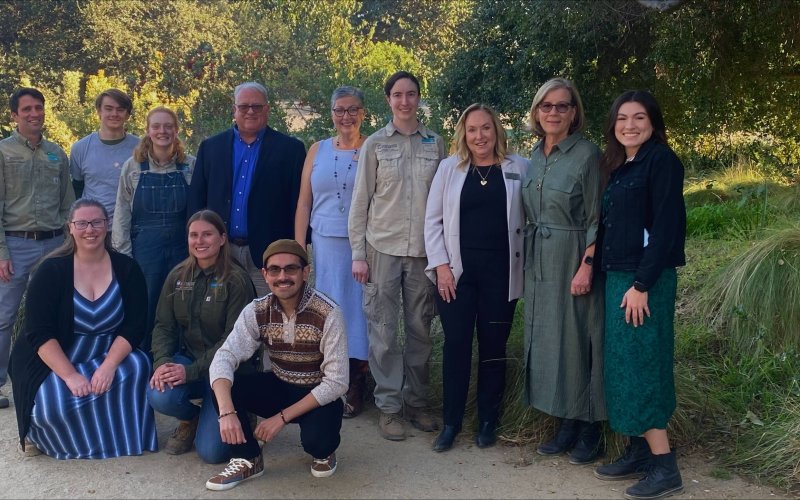
“I have had the time of my life here,” said Greg Dyment, director of the Arboretum and Botanical Garden at Cal State Fullerton, as he plans to retire after almost 28 years.
“I have met so many wonderful people at CSUF and in the community. We could have not done all the things we did without their support. For me, this is the best job in the world, and I am forever grateful,” he added.
Dyment applied for the position of arboretum director on a whim. While living in Washington with his wife and two daughters, he received a letter from a recruiter hired by CSUF to find a director.
“I was running a botanical garden, Lakewold Gardens, in Washington. I replied to the letter, saying I was interested in the job. Before I knew it, the university made me an offer. So, I moved my family off the 160-acre Raft Island in the Puget Sound and moved to Fullerton.”
Dyment, who graduated with a bachelor’s degree in landscape architecture from Cal Poly Pomona, grew up in south Pasadena.
Under his watch, the arboretum became accredited at the highest levels, joining a global community of institutions that have come together to care for rare, endangered and threatened plants from around the world.
It has always been Dyment’s hope that visitors enjoy and appreciate the natural world on display in the gardens.
“We like to say we do what we can to make everybody a tree hugger,” said Dyment.
The Arboretum and Botanical Garden at Cal State Fullerton achieves this goal by collaborating with other institutions to bring plants into the collections that are under threat or extinct in their native habitat. “We plant them at the arboretum and propagate from them, then share the seeds or seedlings with other institutions working to save these plants,” added Dyment.
In fact, it was this work and collaborative research projects with CSUF faculty that helped the arboretum to earn a Level IV accreditation, the highest level possible. “As part of Cal State Fullerton, our arboretum collaborates on research with faculty, engages with other institutions on conservation projects, and has a curator to maintain plant records and share collections data, all of which are requirements for a Level IV accreditation.”
Of course, there have been numerous changes since Dyment’s arrival in 1997.
“When I arrived, we had almost 6 acres in need of development, so we created a collection plan, mapping out different areas — tropical plants, forest areas, cacti and succulents — to plant and maintain,” he said. “The arboretum was also in need of infrastructure improvements such as sewer system upgrades, lighting on the main path from the north end to the south end, and wiring for data links, Wi-Fi, and security cameras.
“We built a nursery with a greenhouse and an office as well as the Bacon Pavilion with classrooms, a kitchen and museum. We made a major upgrade to the irrigation system to conserve water and closely monitor where and when we were watering. We also did a complete redesign of the main entrance and remodeled the bathrooms,” said Dyment.
“More recently, we have been restoring Heritage House with a new roof, new plumbing and fixtures in the restroom, and preparing the house to be a teaching museum for academic programs at CSUF. We are also nearing the completion of the Friends Terrace — a project fully funded through philanthropic investments. This space will be a wonderful new addition for guests to host events.”
In the future, Dyment said he sees the arboretum continuing to care for the world’s rare plants as well as focusing on positioning it as CSUF’s resource for academic work and research.
For example, students and volunteers are now studying the evolving climate and its impacts on the collections as the environment experiences hotter summers and dryer winters. That has brought new pests and diseases that are detrimental to the scientifically relevant living collections.
“Our work with the academic programs in all eight CSUF colleges is very important,” Dyment said. “It has always been my goal to have more research, interns and classes held in the arboretum than the previous semester. I have always dreamed that someday students would want to come to Cal State Fullerton because we have this arboretum.”
Under Dyment’s leadership, the arboretum launched the Engaging Environmental Experiences program in 2022 to facilitate hands-on student learning in the arboretum.
Dyment added that he also has great memories from over the years, including having breakfast with the Dalai Lama when he visited the campus in 2000. A Ficus religiosa was planted in honor of his visit. Today, the tree thrives in the arboretum’s subtropical collection. He also enjoyed seeing attendees celebrate milestone events at the Arboretum and Botanical Garden. And, of course, there was the wedding of his daughter, officiated by his other daughter, where he walked her down the aisle in the Chapman Arbor.
“I am forever grateful for our volunteers, members and donors,” he said. “Fundraising has always been critical to our annual operations and reaching our full potential to inform, engage and advance conservation efforts,” he said. “If not for our donors and volunteers, there would be no arboretum. Our arboretum is more relevant than it has ever been. I am excited to watch its continued evolution and enhancement for the benefit of future generations.”